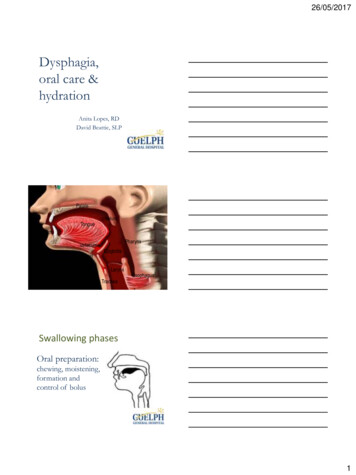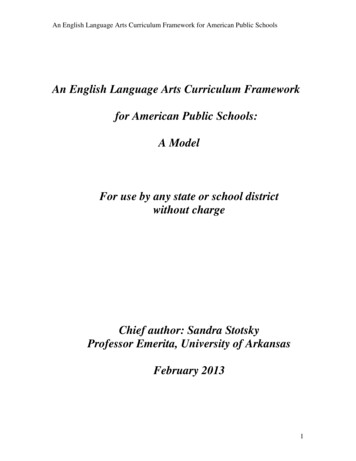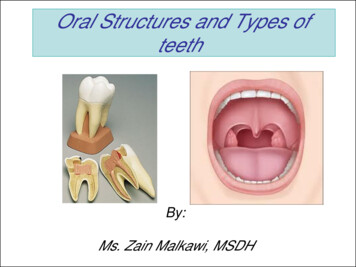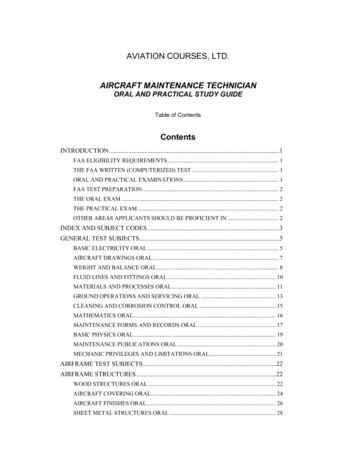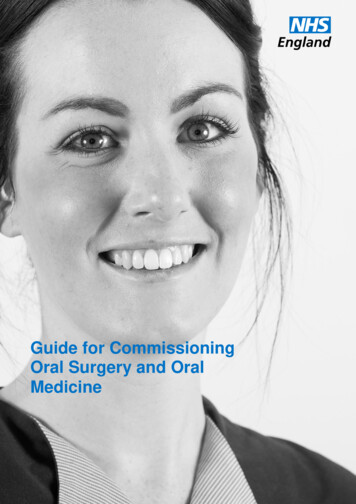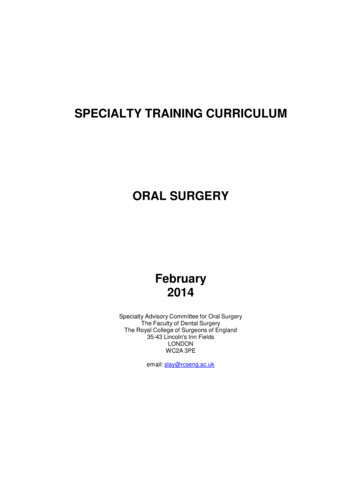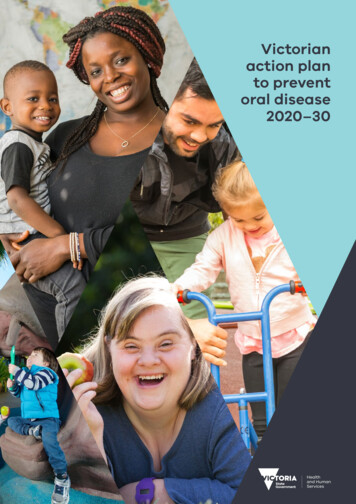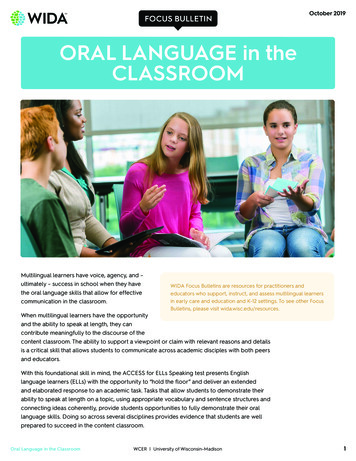
Transcription
FOCUS BULLETINOctober 2019ORAL LANGUAGE in theCLASSROOMMultilingual learners have voice, agency, and –ultimately – success in school when they havethe oral language skills that allow for effectivecommunication in the classroom.WIDA Focus Bulletins are resources for practitioners andeducators who support, instruct, and assess multilingual learnersin early care and education and K-12 settings. To see other FocusBulletins, please visit wida.wisc.edu/resources.When multilingual learners have the opportunityand the ability to speak at length, they cancontribute meaningfully to the discourse of thecontent classroom. The ability to support a viewpoint or claim with relevant reasons and detailsis a critical skill that allows students to communicate across academic disciples with both peersand educators.With this foundational skill in mind, the ACCESS for ELLs Speaking test presents Englishlanguage learners (ELLs) with the opportunity to “hold the floor” and deliver an extendedand elaborated response to an academic task. Tasks that allow students to demonstrate theirability to speak at length on a topic, using appropriate vocabulary and sentence structures andconnecting ideas coherently, provide students opportunities to fully demonstrate their orallanguage skills. Doing so across several disciplines provides evidence that students are wellprepared to succeed in the content classroom.Oral Language in the ClassroomWCER University of Wisconsin–Madison1
Tasks on the ACCESS for ELLs Speaking test are designed to giveWIDA supports the academic achievementstudents precisely this opportunity. Responses to these tasksof ELLs with a strong connection betweencan be evaluated and interpreted with the tools of the WIDAstandards and test design.Standards Framework, which detail linguistic development acrossthe discourse, sentence, and word dimensions of language. Thisconnection between test design and standards is a key feature ofhow WIDA supports the language development and academic achievement of multilinguallearners.We know it’s critical that students develop the ability to communicate effectively in theclassroom. But what kind of language do they need to be successful? What features of spokenlanguage make it possible for a student in a science class to describe how to perform anexperiment or for a student in a social studies class to compare different voting systems?Developing the right kind of language to perform those linguistic tasks is a challenge – and thatchallenge begins with understanding what “the right kind of language” actually means.Tools for Learning about Oral Language in theClassroomWIDA has developed several tools you can use tounderstand the kinds of spoken language students needfor success in the content classroom. These tools—all ofwhich are included in the 2012 Amplification of the WIDAEnglish Language Development Standards resource guide—can spark ideas about how to focus on these skills in thelanguage classroom.The five WIDA English Language Development Standardsstatements describe the language areas in which ELLsmust attain proficiency to access the classroom andcurriculum content. Supporting the ELD Standards is theWIDA Standards Framework, a collection of tools thatdetail the ways language develops as students build thecommunication skills they need for academic success.Dimensions of LanguageSocial and InstructionalLanguageLanguage of Language ArtsLanguage of MathematicsLanguage of ScienceThe WIDA Features of Academic Language describethree distinct dimensions of language: the discourse,sentence, and word or phrase dimensions. The features andperformance criteria of these dimensions vary as students’language skills develop.Oral Language in the ClassroomThe Five WIDA English LanguageDevelopment StandardsLanguage of Social StudiesWCER University of Wisconsin–Madison wida.wisc.edu2
WIDA Features of Academic LanguageAdapted from the 2012 amplification of the English language development standards, Kindergarten-Grade 12Performance CriteriaFeaturesDiscourseDimensionLinguistic ComplexityQuantity and variety oforal and written textAmount of speechStructure of speechDensity of speechOrganization and cohesion of ideasVariety of sentence typesSentenceDimensionLanguage Forms andConventionsTypes, array, and use oflanguage structuresTypes and variety of grammatical structuresConventions, mechanics, and fluencyMatch of language forms to purpose/perspectiveWord/PhraseDimensionVocabulary UsageSpecificity of word orphrase choiceGeneral, specific, and technical languageMultiple meanings of words and phrasesFormulaic and idiomatic expressionsNuances and shades of meaningCollocationsAs students build linguistic skills with the kinds of language used in a classroom, they can dothe following: Speak more, producing a greater volume of spoken language in response to prompts in anacademic context. Speak more fluently, with fewer pauses and less hesitation. Use more technical (academic discipline-specific) words and phrases rather than usinggeneral or vague vocabulary, like “that thing” or “this one.” Use more effective and appropriate collocations or phrases. For example, “save time,” “dohomework,” and “pay attention” are natural-sounding word combinations students mightbegin to use as their language skills develop. Produce a broader variety of grammatical structures. Better organize speech by joining ideas together more effectively and presenting thoughtsin an order that listeners can easily follow.The WIDA Features of Academic Language outline how academic language might vary anddevelop over time. In this Focus Bulletin, we home in on productive language – the languagea student uses to express thoughts and ideas in the classroom – and more specifically orallanguage – the speech choices and patterns that shape a student’s academic voice.Oral Language in the ClassroomWCER University of Wisconsin–Madison wida.wisc.edu3
Linguistic Features of ProductiveLanguageThe WIDA Standards Frameworkincludes another tool that provides adetailed look at the linguistic featuresof language as it develops: theWIDA Performance Definitions. ThePerformance Definitions are expanded,context-specific versions of the moregeneral Features of Academic Language.The Performance Definitions use theWIDA English language proficiencylevels to show the linguistic featuresthat differentiate stages of languagedevelopment.For example, a student at Level 2 might produce short phrases and sentences, use repetitivephrasal and sentence patterns, and communicate with general content words and expressions.Level 2EmergingDiscourse DimensionSentence DimensionWord/Phrase Dimension Phrases or short sentences Emerging expression ofideas Formulaic grammaticalstructures Repetitive phrasal andsentence patterns acrosscontent areas General content words andexpressions Social and instructionalwords and expressions acrosscontent areasHowever, by Level 4, that student can produce some complex sentences, use a variety ofgrammatical structures, and communicate with specific and some technical content-arealanguage.Level 4ExpandingDiscourse DimensionSentence DimensionWord/Phrase Dimension Short, expanded, and somecomplex sentences Organized expressionof ideas with emergingcohesion characteristic ofparticular content areas Compound and complexgrammatical structures Sentence patternscharacteristic of particularcontent areas Specific and some technicalcontent-area language Words and expressions withexpressive meaning throughuse of collocations andidioms across content areasOral Language in the ClassroomWCER University of Wisconsin–Madison wida.wisc.edu4
Key Linguistic Skills for Effective Oral CommunicationThe best tool for exploring the nuance of how oral language evolves as a student’s skillsdevelop is the Speaking rubric, which outlines key linguistic skills necessary for success ina school context. It describes specific levels of expectations for students’ ability to expressthemselves and communicate in content areas.Speaking Rubric of the WIDA ConsortiumGrades 1-12Discourse LevelSentence LevelWord/Phrase LevelLinguistic ComplexityLanguage FormsVocabulary UsageResponse is fully comprehensible, fluent, and appropriate to purpose, situation and audience; comparableto the speech of English proficient students meeting college- and career-readiness standards;characterized by: Level 6Reaching sustained, connected orallanguage characterized byconfidence, coherence, andprecision in the expressionof ideas tailored to purpose,situation, and audienceclear evidence of consistencyin conveying an appropriateperspective and register a full range of oral phraseand sentence patterns andgrammatical structuresmatched to content areatopicscontrolled, skilled use of orallanguage to convey meaning,including for effect consistent usage of just theright word or expression injust the right context relatedto content area topicsfacility with precisevocabulary usage in general,specific, or technical languageResponse is comprehensible, fluent, and generally related to purpose; generally comparable to the speechof English proficient peers; characterized by: Level 5Bridging sustained, connectedoral language that showsappropriate and coherentexpression of ideas relatedto purpose, situation andaudienceclear evidence of conveyingan appropriate perspectiveand register a broad range of oral phraseand sentence patterns andgrammatical structuresmatched to the content areatopiccontrolled, fluid use of orallanguage to convey meaning,including for effect usage of technical andabstract content-areawords and expressions asappropriateusage of words andexpressions with precisemeaning related to contentarea topics as appropriatevocabulary usage that fulfillsthe speaking purposeThe rubric makes it clear, for example, that at advanced stages of language development,students produce spoken language that conveys appropriate perspective and register; usea broad range of sentence structures that align with language use in the relevant academicdiscipline; and employ technical, discipline-specific vocabulary to communicate precisemeaning.Oral Language in the ClassroomWCER University of Wisconsin–Madison wida.wisc.edu5
Oral Language in ContextAs we look closely at how language changes as a student builds the skills described above,it’s important to remember that language development depends on the context in which ithappens.For example, Grade 1 students might produce social and instructional language in the contextof discussing classroom collaboration. They might use technical, discipline-specific vocabularylike “taking turns,” “cooperation,” “job,” “today,” or “tomorrow.” At Level 2, a student canproduce simple statements about working collaboratively, while at Level 5 that student will beable to elaborate on working together, using supports such as a spoken model.In Grade 6, students might use the language of social studies to discuss forms and organizationof government. They might use technical, discipline-specific vocabulary like “forms ofgovernment,” “personal rights,” “equality,” or “the common good.” At Level 2, a student cansuggest detailed features of model governments, potentially incorporating a home language.At Level 5, a student can defend and debate viewpoints on features of model governments.ProficiencyLevel 1ProficiencyLevel 2ProficiencyLevel 3ProficiencyLevel 4ProficiencyLevel 5 broad range ofsentence patterns words with precisemeaning simple statements general wordsand expressionsIn summary, the oral language we expect studentsto produce varies by their individual level ofdevelopment and the discipline or content areawith which they are engaging. By analyzing thevocabulary, sentence, and discourse features ofstudents’ spoken language, we can compare theskills of one student to another and place students’performance along the continuum of the WIDAproficiency levels.By giving students a chance to show their skills andby giving educators and raters a chance to evaluatethose skills using the WIDA standards framework,the ACCESS for ELLs Speaking test helps usunderstand both what students can already do andwhere they may need to improve.Oral Language in the ClassroomWCER University of Wisconsin–Madison wida.wisc.edu6
WIDA FOCUS BULLETIN CLOSER LOOKACCESS for ELLs Speaking TestThe ACCESS for ELLs Speaking test is designed to assess the academic oral language skills defined in theWIDA Performance Definitions. The test requires students to process and respond to academic contentacross the five WIDA ELD Standards. Test tasks are designed to elicit oral language at beginner, intermediateand advanced levels of language proficiency.Let’s take a look at how the detail of the Features of Academic Language, Performance Definitions, andSpeaking rubric inform how to evaluate student responses to two sample ACCESS for ELLs Speaking tasks.The sample tasks below are for the Grades 6–8 grade-level cluster and use the Language of LanguageArts and the Language of Social Studies. You can find one of the items discussed here, as well as additionalsample items, at wbte.drcedirect.com/WIDA/portals/wida.Task 1: Level 3Students are presented with biographical information about a historical figure – in this case, the Americanmusician Scott Joplin. Content is delivered multi-modally: students listen to or read the task input and havegraphic support on each screen providing meaningful context.Oral Language in the ClassroomWCER University of Wisconsin–Madison7
WIDA FOCUS BULLETIN CLOSER LOOKAfter the content is presented, the virtual test administrator presents a speaking task to the model student,Nina.The questions posed to Nina correspond in difficulty and opportunity to the tasks presented to thestudent. Nina demonstrates how students should respond, modeling the length and complexity ofa very effective spoken response. Each task targets a particular proficiency level, as defined in theWIDA Performance Definitions and Speaking rubric. Nina’s response reflects the expectations ofthe targeted level. Therefore, in addition to being a model for students, Nina’s response serves as alanguage-use benchmark for raters who score students’ responses relative to Nina’s.Oral Language in the ClassroomWCER University of Wisconsin–Madison8
WIDA FOCUS BULLETIN CLOSER LOOKTest-takers listen to Nina’s response before they are presented with a comparable speaking task. Test-takersrecord their responses using the recording feature built into the online test platform.Features of Oral Language in Responses to a Level 3 TaskModel Task:Tell me about Joplin’s early life.Nina’s Response: Scott Joplin’s family loved music. When he was growing up, both his parents playedinstruments, and he learned to play instruments, too. A music teacher heard about his talentand taught him how to play piano.Nina recounts, in her own words, the content of the first half of the task input. Her explanation of the first andsecond pictures is characterized by a combination of simple and complex sentences and some disciplinespecific vocabulary: “growing up,” “played instruments,” “talent,” “taught him how to play piano.” Nina’sresponse demonstrates how to respond to the task and the level of linguistic complexity that is expected in aLevel 3 response. Her response completely fulfills the task expectations.Oral Language in the ClassroomWCER University of Wisconsin–Madison9
WIDA FOCUS BULLETIN CLOSER LOOKNow consider some actual studentresponses to a comparable task,taken directly from ACCESS for ELLs.Student Task:Tell me about some things ScottJoplin did as a young adult.Student Response 1:He started playing piano at a cluband then began to write his ownmusic.This response is relevant to the task,but it lacks the linguistic complexitythat could be anticipated at Level 3 inGrades 6–8. An appropriate rating forthis response is Adequate.Student Response 2:When Scott was a young adult, heplayed the piano also along withhis parents. He learned how to playpiano by a famous piano player. Andhe taught Scott how to play.Student responses are scored according to the ACCESSfor ELLs Speaking Scoring Scale, used by both local testadministrators and centralized raters.ACCESS for ELLs Speaking Scoring ScaleScore pointExemplary use of orallanguage to provide anelaborated responseStrong use of orallanguage to provide adetailed responseAdequate use of orallanguage to provide asatisfactory responseAttempted use of orallanguage to provide aresponse in EnglishResponse characteristics Language use comparable to or goingbeyond the model in sophisticationClear, automatic, and fluent deliveryPrecise and appropriate word choiceLanguage use approaching that ofmodel in sophistication, though notas richClear deliveryAppropriate word choiceLanguage use not as sophisticated asthat of modelGenerally comprehensible use of orallanguageAdequate word choiceLanguage use does not support anadequate responseComprehensibility may becompromisedWord choice may not be fullyadequateNo response (in English) Does not respond (in English)This response shows a mix of simpleand complex sentences. The minorerrors do not interfere with theintended message, and the response includes appropriate vocabulary: “played the piano,” “learned,” and“taught Scott how to play.” An appropriate rating for this response is Strong.Oral Language in the ClassroomWCER University of Wisconsin–Madison10
WIDA FOCUS BULLETIN CLOSER LOOKStudent Response 3:When he was a young adult, Scott Joplin was a musician who liked playing the piano, and he wrote songs.Everyone in his family loved to play music. He played piano in churches and parties, so he could continue hismusic education. Then, he became began to write his own songs.This response demonstrates a high level of proficiency in oral language, connecting ideas with appropriatedevices such as “who liked,” “so he could,” and “then, he became.” The response includes a variety ofdiscipline-specific and task-relevant vocabulary (“musician,” “wrote songs,” “played piano,” “music education,”“write his own songs”) that builds specificity into the response. This response goes beyond the standardestablished by the model response, so an appropriate rating for this response is Exemplary.Task 2: Level 5Students are presented with additional biographical information about Scott Joplin. To help them listen andread strategically, the question they’ll be asked is previewed.Oral Language in the ClassroomWCER University of Wisconsin–Madison11
WIDA FOCUS BULLETIN CLOSER LOOKTest-takers see the prompt that was previewed and record their responses after listening to Nina’s responseto the same prompt.Features of Oral Language in Responses to a Level 5 TaskModel task:Nina, now that you’ve heard about Scott Joplin’s life, I want you to think of a word thatdescribes him. Tell me which word you chose, and why you picked that word.Nina’s Response: The word I chose is ‘determined.’ I think Scott Joplin was determined because he workedhard for a long time to make music in a new style. He started creating music when hewas young and didn’t give up. He even brought ragtime style to other forms of music likeopera. His opera was not successful at first, but eventually his work became very popular.This took determination.Nina uses complex syntax, for example: “ was determined because he worked hard for a long time to makemusic .” Nina also produces discipline-specific vocabulary, including “music in a new style,” “creating music,”“ragtime,” “opera,” and “determination.” This response reflects a level of language proficiency consistent withthe Level 5 descriptions in the WIDA Performance Definitions.Oral Language in the ClassroomWCER University of Wisconsin–Madison12
WIDA FOCUS BULLETIN CLOSER LOOKLevel 5BridgingDiscourse DimensionSentence DimensionWord/Phrase Dimension Multiple, complexsentences Organized, cohesive, andcoherent expression ofideas A variety of grammaticalstructures matched topurpose A broad range of sentencepatterns characteristic ofparticular content areas Technical and abstractcontent-area language,including content-specificcollocations Words and expressions withprecise meaning acrosscontent areasNow consider some student responses to this task.Student Task:Nina picked the word ‘determined.’ Now it’s your turn. Think about everythingyou’ve learned about Scott Joplin. Choose a different word that describes Joplin,and tell me why you picked that word.Student Response 1: Confident. He’s confident of what he do, of what he does. He likes what he does andhe’s just confident.This response is on topic but lacks the complexity of the model response. The student does not use anydiscipline-specific vocabulary. While the response does show what the student can do with language, itdoesn’t fully meet the expectations of a Level 5 task. An appropriate rating for this response is Adequate.Student response 2:The word I picked was creativity because, um, Scott Joplin was creative. He startedmaking, he started writing music since he was little. And now he he has become theking of Ragnet. He has made lots of musics and, um, staged opera and more.This response nears the syntactic and lexical complexity of the model response. The student appropriatelyincorporates some discipline-specific vocabulary, such as “creative,” “writing music,” “king of Ragnet [sic],”“made lots of music,” and “staged opera,” but the response uses a smaller variety of sentence structures thanthe model response. An appropriate rating for this response is Strong.Student response 3:Oral Language in the ClassroomI would pick the word inspire because he would inspire me to not give up on mydreams, and he worked really hard for his. He even worked hard for his own theaterand now he is remembered for a lot. He would inspire a lot of children, a lot of kidsto not give up for what they’re looking for in their life. And I won’t give up on mine,thanks to Scott Joplin.WCER University of Wisconsin–Madison13
WIDA FOCUS BULLETIN CLOSER LOOKThis response uses a variety of complex sentence structures as well as a wide variety of appropriatevocabulary and accurate collocation (for example, “give up on my dreams,” “not give up,” “he is rememberedfor,” and, “what they’re looking for in their life”). The student’s last sentence delivers a clear closing to theresponse and contributes a cohesive expression of ideas. This response is comparable to the standardestablished by the model response, so an appropriate rating for this response is Exemplary.The Vocabulary Usage descriptors from Level 5 of the Speaking rubric help to explain howstudents employ lexical resources to produce proficient academic oral language.Speaking Rubric of the WIDA ConsortiumGrades 1-12Discourse LevelSentence LevelWord/Phrase LevelLinguistic ComplexityLanguage FormsVocabulary UsageResponse is comprehensible, fluent, and generally related to purpose; generally comparable to thespeech of English proficient peers; characterized by: Level 5Bridging sustained, connectedoral language that showsappropriate and coherentexpression of ideas relatedto purpose, situation andaudienceclear evidence of conveyingan appropriate perspectiveand register a broad range of oral phraseand sentence patterns andgrammatical structuresmatched to the content areatopiccontrolled, fluid use oforal language to conveymeaning, including for effect usage of technical andabstract content-areawords and expressions asappropriateusage of words andexpressions with precisemeaning related to contentarea topics as appropriatevocabulary usage that fulfillsthe speaking purposeFeatures of Oral Language across ProficiencyLevelsThe student responses in the Closer Look show how oral language varies as proficiencydevelops. Student responses rated Strong and Exemplary are characterized by original andacademic vocabulary use beyond the language delivered in the task, while the Adequateresponses satisfy the prompt but don’t demonstrate the complexity and discipline-specificvocabulary of the model student response.These examples show how the three dimensions of academic language – the discourse,sentence, and word or phrase dimensions – differentiate spoken language across the levelsOral Language in the ClassroomWCER University of Wisconsin–Madison14
of oral language proficiency. As proficiency increases, students are able to produce a widervariety of simple and complex sentence structures, and they more frequently and more clearlyuse connective devices to link ideas.The tools of the WIDA Standards Framework detail the features of oral language that allowstudents to communicate effectively in school contexts. Understanding what those featuresare and how they appear in practice can help you to both identify the expectations of theACCESS for ELLs Speaking test and plan classroom instruction that helps students develop thesentence structures, vocabulary, and expressive organization skills critical to their success inthe classroom and beyond.REFLECTIONAs students’ proficiency increases, they move from using simple to more complex sentence structures, joiningideas with connectors like “because,” “so,” and “however” or sequence terms like “first,” “next,” “then,” “later,”and “finally.” What classroom activities encourage students to use these kinds of connectors? What can you do to encourage students to join ideas together when they speak?Employing technical, discipline-specific vocabulary is one critical way students express themselves clearly inacademic contexts. What can you do to encourage students to use less general terminology and instead developvocabulary that is specific and uniquely appropriate to academic contexts, like the language used insocial studies or science textbooks?In casual conversation, speakers can respond directly to previous comments with simple statements andimprecise language. In school communication, speakers often respond to multiple arguments and maintainclarity by using specific language, rather than pronouns like “it” or “that,” to connect ideas within an audience’sbody of prior knowledge. What can you do to encourage students to use discipline-specific nouns and noun phrases rather thangeneric pronouns?Oral Language in the ClassroomWCER University of Wisconsin–Madison wida.wisc.edu15
Additional ReadingBrisk, M. E., & Zhang-Wu, Q. (2017). Academic language in K–12 contexts. In E.Hinkel (Ed.). Handbook of research in second language teaching and learning,Volume 3 (pp. 82-100). New York: Routledge.Bailey, A. (2017). Progressions of a new language: Characterizing explanationdevelopment for assessment with young language learners. Annual Review ofApplied Linguistics, 37, 241-263.Bailey, A. L. and Heritage, M. (2014), The role of language learningprogressions in improved instruction and assessment of English languagelearners. TESOL Quarterly, 48: 480-506.Fulcher, G. (2015). Assessing second language speaking. Language Teaching,48(2), 198-216.Fulcher, G. (2014). Testing second language speaking. RoutledgeGan, Z. (2013) Task type and linguistic performance in school-basedassessment situation. Linguistics and Education, 24(4), 535-544.Contributing AuthorsMark ChapmanDale ErlandsonWIDA FocusBulletin StaffRebecca HolmesJanet TrembleyGibbons, P. (2006). Bridging discourses in the ESL classroom: Students,teachers and researchers. London: Continuum.Hawkins, M. R. (2004). Researching English language and literacydevelopment in schools. Educational researcher, 33(3), 14-25.Hsieh, C.-N., & Wang, Y. (2019). Speaking proficiency of young languagestudents: A discourse-analytic study. Language Testing, 36(1), 27–50.Iwashita, N., Brown, A., McNamara, T., & O’Hagan, S. (2008). Assessed levelsof second language speaking proficiency: How distinct? Applied linguistics,29(1), 24-49.Lin Gu & Ching-Ni Hsieh (2019) Distinguishing features of young Englishlanguage learners’ oral performance. Language Assessment Quarterly, 16:2,180-195.Schleppegrell, M. J. (2013). The role of metalanguage in supporting academiclanguage development. Language Learning, 63, 153-170.Valdés, G. (2004). Between support and marginalisation: The developmentof academic language in linguistic minority children. International Journal ofBilingual Education and Bilingualism, 7(2-3), 102-132.Oral Language in the ClassroomWCER University of Wisconsin–Madison wida.wisc.edu16
Oral Language in the Classroom WCER University of Wisconsin-Madison wida.wisc.edu 5 Key Linguistic Skills for Effective Oral Communication The best tool for exploring the nuance of how oral language evolves as a student's skills



